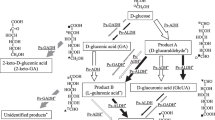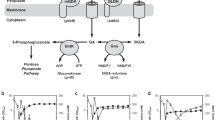Summary
When G. oxydans ATCC 621-H was grown in batch culture in a complex medium with glucose, ketogluconates were produced when the pH in the culture was maintained at 5.5. Without pH control gluconate was the only product of glucose oxidation, but at pH 5.5 the gluconate so produced was further oxidized to ketogluconates. Production of ketogluconates started when glucose was almost completely exhausted. It was shown that the actual glucose and gluconate concentrations in the culture do not determine the onset of ketogluconate formation during growth. Both 2 and 5 ketogluconate were produced. Addition of CaCO3 to the medium favored the production of 5 ketogluconate. However, under these conditions minor quantities of 2 ketogluconate were also formed. The sequential production of gluconate and ketogluconates from glucose was not only restricted to G. oxydans ATCC 621-H. A number of G. oxydans strains when grown under standard conditions in a pH controlled batch culture, all produced ketogluconates from glucose via an intermediate accumulation of gluconate. Although the ratios of the ketogluconates produced varied from strain to strain, all strains produced both 2 and 5 ketogluconate.
Similar content being viewed by others
References
Agapova EV, Goncharova LA, Kaptereva YuV, Kozhobekova KK, Rubtsov JA, Pomortseva NV, Tarnpolskaya IP, Gofman LKh (1976) SU Patent 603659
Asai T (1968) Acetic acid bacteria. University of Tokyo Press, Tokyo, Japan
Asai T (1971) The classification and biochemistry of acetic acid bacteria. In: Sakaguchi K, Uemura T, Kinoshito S (eds) Biochemical and industrial aspects of fermentation. Kodansha Ltd, Tokyo, Japan, pp 201–232
Boutroux L (1886) Sur une fermentation acide du glucose. C R 102:924–927
De Ley J (1960) Comparative carbohydrate metabolism and localization of enzymes in Pseudomonas and related microorganisms. J Appl Bact 23:400–441
Harder W, Visser K, Kuenen JG (1964) Laboratory fermenter with an improved magnetic drive. Lab Practice 23:139–150
Katznelson H, Tanenbaum SM, Tatum EL (1953) Glucose, gluconate and 2-ketogluconate oxidation by Acetobacter melanogenum. J Biol Chem 204:43–59
Kheshgi S, Roberts HR, Bucek W (1954) Studies on the production of 5-ketogluconic acid by Acetobacter suboxydans. Eur J Appl Microbiol 2:183–190
Kita DA, Fenton DM (1982) Preparation of 2,5 diketogluconic acid. US Patent 4316960
Kluyver AJ, Boezaardt AGJ (1938) On the oxidation of glucose by Acetobacter suboxydans. Rec Trav Chim 57:609–615
Lockwood LB (1954) Ketogenic fermentation processes. In: Underkofler LA, Mickey RF (eds) Industrial fermentations. Chemical publishing Co Inc, New York, pp 1–21
Lowry OH, Rosenbrough HJ, Farr AL, Randall RJ (1951) Protein measurement with the Folin phenol reagent. J Biol Chem 193:265–275
Melberg JBM, Spa MA (1983) Microbial production of gluconic acid and gluconates. Ant v Leeuwenhoek 49:89–90
Olijve W, Kok JJ (1979a) Analysis of growth of Gluconobacter oxydans in glucose containing media. Arch Microbiol 121:283–290
Olijve W, Kok JJ (1979b) An analysis of the growth of Gluconobacter oxydans in chemostat cultures. Arch Microbiol 121:291–297
Shchelkunova SA, Voinova GN (1969) Influence of the conditions of culturing on the formation of the calcium salt of 5 ketogluconic acid by acetic acid bacteria. Mikrobiologiya 38:583–588
Shinagawa E, Matsushita K, Adachi O, Ameyama M (1983) Selective production of 5 keto-d-gluconate by Gluconobacter strains. J Ferment Technol 61:359–363
Stadler-Szöke A, Nyeste L, Holló J (1980) Studies on factors affecting gluconic acid and 5 keto-d-gluconic acid formation by Acetobacter. Acta Aliment 9:155–172
Stouthamer AH (1960) Koolhydraatstofwisseling van de azijnzuur bacteriën. Ph. D. Thesis, University of Utrecht
Stubbs JJ, Lockwood LB, Roe ET, Tabenken B, Ward GE (1940) Bacterial production of ketogluconic acids from glucose. Ind Eng Chem 32:1626–1631
Stubbs JJ, Lockwood LB, Roe ET, Ward GE (1943) Fermentation process for the production of 5 ketogluconic acid. US patent 2318641
Author information
Authors and Affiliations
Rights and permissions
About this article
Cite this article
Weenk, G., Olijve, W. & Harder, W. Ketogluconate formation by Gluconobacter species. Appl Microbiol Biotechnol 20, 400–405 (1984). https://doi.org/10.1007/BF00261942
Received:
Issue Date:
DOI: https://doi.org/10.1007/BF00261942




